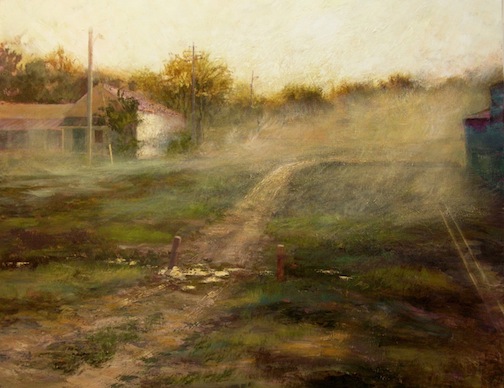linda fantuzzo article By Jack McCray
 |
| Roving Fog 42x54 |
Evidence, they say, of her artistic maturation is a new 22-piece exhibition, "Edges," hanging at one of the most prestigious purveyors of fine art of the American South, The Charleston Renaissance Gallery.
Fantuzzo, who arrived in Charleston in 1973 from Philadelphia, has included in this show landscapes and still-lifes. Her friend and curator, Roberta Sokolitz, wrote in the "Edges" catalog that the compositions shown are "painted with an ongoing concern for expressive form, light, color, atmosphere, and content.
This selection of recent paintings reveals her mastery of these subjects and techniques, in views seen at edges of places." Some of those places include bridges, roads, marsh, facades and industrial sites.
She adores the natural light in Charleston.
She compares it to the light around the Mediterranean Sea, where she also has painted. "It fills the shadows," she said in a recent interview. "There's so much reflected light. ... I feel that the quality of air here (Charleston) is almost tangible, palpable."
So, for her, natural elements are a big deal.
"Atmosphere is all-inclusive," Fantuzzo said. "It envelops our entire being, physically and emotionally. Fog can obliterate the obvious. The white haze will soften the unattractive. Rain will wash clean the unacceptable. Sunshine can reveal what has been hidden and make beautiful the mundane."
"She's also interested in how light filters through atmosphere," Sokolitz said of Fantuzzo, whose studio is downtown. "We have a lot of haze and morning fog. Sometimes you can look into it and see this light itself, and other times, it's exquisite as it reflects off the water."
Sokolitz wrote the essay in the exhibition catalog.
"I've known Linda since around 1980, having worked for the Gibbes and Spoleto," she said in an interview. "I work principally for the Charleston Renaissance Gallery now, and when she and I had the opportunity to develop this exhibition together, we did become friends."
Angela Mack, longtime chief curator and now executive director of the Gibbes Museum of Art, has worked with Fantuzzo for many years. "Having had the opportunity to organize for the Gibbes two major exhibitions on the work of Linda Fantuzzo, I am delighted by the recent attention she is receiving through the Renaissance Gallery," she said.
Dr. Ron Porter, a retired physician living in Columbia, collects Fantuzzo's works.
"I have several of her paintings, and they're all very special," he said in a telephone interview. "I first met Linda about 20 years ago. She had a painting in a South Carolina show. It opened at the Gibbes. She had a strong piece. It was figurative, not what she's doing now. ... She captures light on canvas that's just extraordinary. Her paintings have been like this for a long time. She gets better and better every year."
Fantuzzo's paintings are intriguing in the way she uses light and perspective. This is most evident in her paintings that contain an image of a painting. The viewer gets two perspectives on light, the one in the image of a painting and the broader one of the painting itself.
Fantuzzo is a gallery artist at Joie Lassiter Gallery in Charlotte. Lassiter said in an e-mail exchange, "Indeed Fantuzzo utilizes the modalities of classical Italian painters in terms of the filtration of light, which stands as an important aspect of her paintings. However, it is my contention that within the Southeastern geography, it is Fantuzzo's specific choice of subject and composition within traditional painting genres that will eventually set her far apart from her contemporaries.
"The placement of still life objects within the picture plane of landscape and settings such as demolished buildings, deserted industrial complexes and discarded environments gives a new context to regional painting. The combination of all these elements, both classical and contemporary, leans toward a new conceptual ideal within the realms of Southern landscape."
Fantuzzo is also particular about the materials she uses - the surfaces she paints on and the type of paint with which she works. Most of the works in "Edges" are acrylic on birch.
